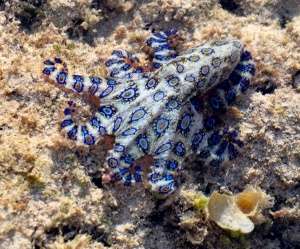Tetrodotoxin
Background
- Neurotoxin found in several marine animals (pufferfish, certain angelfish, blue-ringed octopus)
- Heat-stable toxin not destroyed by washing, freezing or cooking
- Blocks neuronal action potential by blocking voltage-gated sodium channels
- Consumption of improperly prepared pufferfish responsible for vast majority of human toxicity (e.g. fugu restaurants)

Mechanism of Injury
- Tetrodotoxin binds to and blocks fast-gated sodium channels, blocking conduction of nerve signals.
Clinical Features
Onset of symptoms usually within 30 min to 4 hours after eating pufferfish
- Paresthesias, body numbness
- Dysarthria, dysphagia
- Headache
- Vomiting, diarrhea, abdominal pain
- Ascending paralysis
- Respiratory failure
- Death
Differential Diagnosis
Marine toxins and envenomations
- Toxins
- Stingers
- Venomous fish (catfish, zebrafish, scorpion fish, stonefish)
- Cone shells
- Lionfish
- Sea urchins
- Nematocysts
- Coral reef
- Fire coral
- Jellyfish (Cnidaria)
- Portuguese man-of-war
- Sea anemones
- Phylum porifera (sponges)
- Bites
Evaluation
- Pufferfish can be tested for the toxin, but decision to treat should be based on clinical picture
- Evaluate for other treatable causes of symptoms
Management
- Supportive care is mainstay of treatment
- May require intubation if concern for progressive paralysis
- Acetylcholinesterase inhibitors (e.g. neostigmine)
Disposition
- Admit (may need ICU)
External Links
See Also
References
Video
START_WIDGETb603fc68f831fbf3-0END_WIDGET
This article is issued from
Wikem.
The text is licensed under Creative
Commons - Attribution - Sharealike.
Additional terms may apply for the media files.